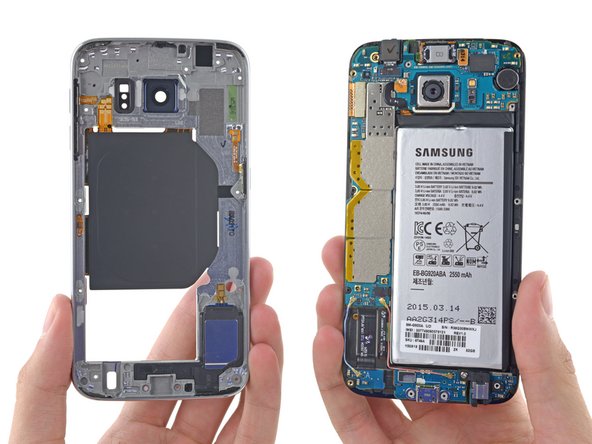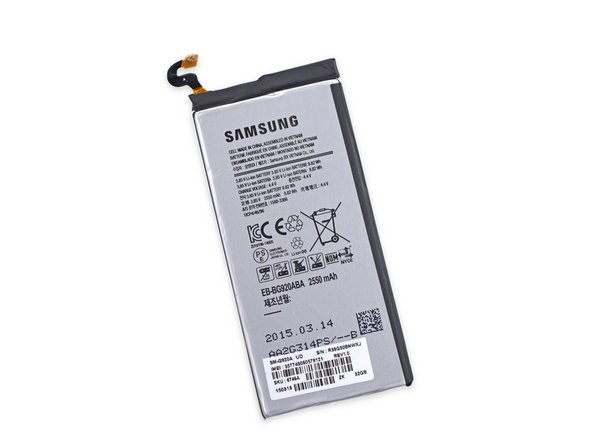News
Samsung Galaxy S6 Teardown
Date: 01-24-2018 Click: 0Step 1 Samsung Galaxy S6 Teardown
Compared with the S5, the S6 certainly looks good on paper. Its specs line up point-for-point with the flashy S6 Edge:
5.1" Super AMOLED capacitive touchscreen (1440 x 2560 pixels, ~577 ppi, 16M colors)
Exynos 7 Octa 7420 Processor with integrated Mali-T760 GPU and 3 GB memory
16 MP rear camera with HDR, LED Flash, and dual-video recording
Built-in wireless charging
32, 64, and 128 GB storage options
Corning Gorilla Glass 4 backing
It's got more power. It's got more pixels. Still, it feels like something's missing. We can't quite put our finger on it, so let's dig our fingers into it. It's teardown time!
Step 2
Just like its edgier sibling, the new Galaxy sports Gorilla Glass 4 on its front and back faces.
A view of the edge of the Galaxy.
At .27 inches, the S6 comes in just a hair thinner than its sister Galaxy, the S6 Edge (.28 inches).
Thinner, but not smaller—the S6 is slightly taller and wider than its sibling, and comes in a tiny bit (6 grams) heavier.
Step 3
After wrestling with a brief bout of déjà vu, our trusty Heavy Duty Suction Cup and opening pick get us inside.
Looks like the S6 and S6 Edge are going to have a lot in common inside as well as out.
Step 4
The rear panels are so similar we had to put them to the side-by-side comparison test: as we should have expected, the S6 Edge (right) panel is slightly smaller than the standard S6 (left) panel.
The adhesive stayed globbed to the midframe this time, hiding the screws. We had a moment of panic, thinking we'd have to go through the display, S5-style.
But after peeling up the adhesive, all screws are present and accounted for—and now, removed!
Step 5
It's time to blow this Galaxy wide open.
Removing the midframe reveals... an S6 Edge?
Maybe not—but it takes a keen eye to spot the difference. Apart from a slight rejiggering of the vibrator placement, these internals are a dead ringer for that other flagship Samsung smartphone we tore down recently.
Step 6
Who runs the phone? Battery!
Removing the battery from the S6 should be a little bit easier than from the Edge. In the Edge, the battery cable was routed under the motherboard before connecting on top, necessitating removing the motherboard to get to the battery.
Looks like with the bit of extra room inside the regular S6, Samsung was able to run the cable on top of the board, to save a step for battery removal.
Also, thanks to the flat-screen design of the S6, it's easier to push an opening pick straight into the gap between the battery and display assembly, making it easier to cut the (just-as-strong) adhesive holding the battery.
This hardly qualifies as a user-replaceable battery, but it is a bit easier than in the S6 Edge. Still, it's a flying leap backwards from previous Galaxies like the S5, where you could replace the battery using nothing but your wits, and you didn't even really need those.
Step 7
The Galaxy sports a 3.85 V, 9.82 Wh battery, which Samsung claims will provide up to 23 hours of 3G talk time, 12 hours of Wi-Fi internet use, and up to 57 hours of music playback.
With the transition to heavier case materials, perhaps Samsung was interested in cutting weight by trimming batteries. The 9.82 Wh battery in the S6 and 10.01 Wh battery in the S6 Edge feel pretty small compared to the Galaxy S5's 10.78 Wh pack.
The battery is quite a bit bigger than the 6.91 Wh we saw in the iPhone 6, but arguably provides less talk time. It seems like that extra screen real estate takes a lot of juice.
Step 8
The motherboard is still held by the gravitational pull of a pesky daughterboard connector. We quickly set to work with a spudger and lift off to get a closer look.
Step 9
We grab some tweezers and take a closer look at the Galaxy's cameras.
The S6's 5 MP selfie camera is the spitting image of the front-facing camera we found in its sister Galaxy.
The similarities don't end there. The 16 MP OIS rear-facing camera looks nearly identical to the one in the Edge. There is definitely some similar hardware on this PCB:
Winbond W25Q32FW Serial Flash Memory
InvenSense IDG-2030 dual axis gyroscope for optical image stabilization
Step 10
We scope out the back side of the motherboard first, and find some familiar heavy hitters:
Samsung Exynos 7420 Octa-core Processor - 64-bit, 2.1 GHz Quad + 1.5 GHz Quad, with Samsung K3RG3G30MM-DGCH 3 GB LPDDR4 RAM layered in
Samsung KLUBG4G1BD 32GB NAND Flash
Skyworks 78041 Hybrid Multimode Multiband (MMMB) Front-End Module (FEM)
Avago AFEM-9020 PAM
Broadcom BCM4773 GNSS Location Hub
Samsung C2N8AF (possibly image processor)
Avago A7007 (seen previously in the Galaxy S5)
Step 11
A few more familiar faces grace the front side of the mobo:
Wolfson Microelectronics WM1840 Audio Codec
Samsung S2MPS15 (likely power management IC similar to the S2MPS11)
Samsung Shannon 928 RF Transceiver
Maxim MAX77843 Companion PMIC
Maxim MAX98505 Class DG Audio Amplifier
Samsung Shannon 600B5D
Step 12
We attempt to pry up the daughterboard, but are thwarted by soft button LED cables.
The soft button LED cables are trapped between the display and the display backing frame.
So we pry up the display frame to release the daughterboard.
Step 13
Once extricated, the daughterboard provides a clear view of its audio jack and space-aged microUSB (2.0) port.
This represents another seeming step backwards from the S5, which packed a 10x faster USB 3.0 port.
Onboard, we spy a single IC:
Cypress 3175 1501 1885 (likely touch or fingerprint sensor controller)
Step 14
With the display removed, we find the sameSTMicro FT6BH touchscreen controller as the S6 Edge.
Step 15

Samsung Galaxy S6 Repairability Score: 4 out of 10 (10 is easiest to repair).
Many components are modular and can be replaced independently.
The S6 doesn't have the S5's display-first entry, but the display still needs to be removed if you want to replace the USB port.
Unlike the S6 Edge, the battery can be removed without first ousting the motherboard—but tough adhesive and a glued-on rear panel make replacement more difficult than necessary.
Front and back glass make for double the crackability, and strong adhesive on the rear glass makes it very difficult to gain entry into the device.
Replacing the glass without destroying the display is probably impossible.
Products Sort
- Finger Spinner
- Apple Mobile
- Samsung Mobile
- Xiaomi Mobile
- Huawei Mobile
- LG Mobile
- Motorola Mobile
- Sony Mobile
- Asus Mobile
- OPPO Mobile
- Meizu Mobile
- Vivo Mobile
- LeEco Mobile
- Mobile Phone TOOLS
- PlayStation4
- PlayStation3
- PlayStation2 & PS1
- PSP1000/2000/3000/Go/PSV
- Xbox360 & Xbox & One
- Wii & GameCube
- NDS lite/NDS-i/3DS/3DS XL/2DS
- ND & GBA
- Memory Card
- DS Flash Card
- ModChip
- Other accessories
- Samsung Galaxy S6 Teardown






























